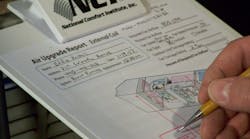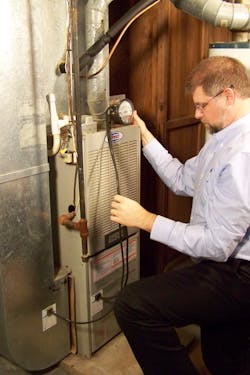Many people claim that HVAC system accessories are silver bullets that assure the system will deliver maximum comfort and efficiency. Unfortunately, despite such claims, these accessories may only mask the real problem stemming from the original system design and. The duct system is often the real cause of your customer’s comfort and efficiency problems. Let’s take a look at the ultimate equipment replacement accessory: upgrading the duct system.
Patch vs. Fixes
Reports from the field confirm the installation of many system accessories often fail to provide a permanent solution. Many cannot function as designed until the system performs correctly.
Zoning systems may be offered as a patch for undersized or poorly installed ducts. Filter systems are installed to cover up leaking return ducts, pulling contaminants into or creating building pressure imbalances.
Humidifiers are frequently installed to try and offset over-pressurization that drives humidity out of buildings in winter months. Customers often ask for larger equipment because their existing system operates at half its rated capacity. Dehumidifiers are often installed to offset duct system leakage that pulls humid outside air into buildings.
Whether the accessory is a patch or a fix depends on testing and diagnostics to uncover the root cause of the problem.
Duct Renovations are a Custom-Made Accessory
Static pressure testing is one of the tests that are part of the out-of-the-box diagnostic procedures that make duct renovations a custom accessory.
PHOTO: Static pressure testing is one of the tests that are part of the out-of-the-box diagnostic procedures that make duct renovations a custom accessory.
Like most things that are good, system renovation needs to be pursued with each customer. This highly profitable opportunity will not come knocking on your door. Most customers haven’t been introduced to the idea by your competitors. A little testing by you often reveals the core solutions to most customer needs.
Many contractors have been renovating and upgrading systems for years. Their sales process includes diagnostic procedures to distinguish themselves from their competitors to earn the appreciation of their customers.
Many other contractors are more interested in fast installation turnarounds. Consider all the condensing units that you’ll replace this summer. True, a condensing unit change out is a high-profit opportunity and low labor risk, and you would have to be crazy to miss the opportunity. But, please look beyond the equipment for solutions outside the box. That is where you’ll find the real opportunity.
There are different system renovation levels that an HVAC contracting company can offer. Each job is custom-designed, fabricated, and installed by you, based on the customer’s individual needs revealed by you testing static pressure, airflow, temperature, and humidity. Only testing and diagnostics allow you to see hidden problems and offer solutions.
Face it, when you are called out to change a condensing unit, people aren't relishing the idea of paying for a new one. The truth is that contractors sometimes limit what they offer customers because they’re focused on quick and simple equipment changeout. If they fail to look deeper, they fail to provide the benefits most customers really want.
When a major system component is replaced, this may be the first time a customer has given more than a minute thought regarding their HVAC system in 15 years. Your customer is often in the best position to act on those repairs now, especially when his or her knowledge and awareness of the system is peaked.
How Much?
Anyone who does diagnostic testing in the presence of customers is aware of the discovery and new knowledge those customers experience relating to the comfort issues they’ve been living with. They immediately recognize the value of improving the obvious defects they just found.
HVAC system renovations sell from $1,000 to $20,000 or higher. The average cost is approximately $3,200, excluding any equipment replacement. Is this too much to offer a customer? What if it increases system performance by 30%? Now is the cost too high?
Once customers understand how system comfort and efficiency are being negatively impacted by a faulty duct system, the value of a system renovation skyrockets and becomes key to whether you get the job.
PHOTO: Completing an air upgrade report, to document duct improvements made.
Typically, testing and diagnosing an HVAC system is about an hour’s work. Testing is included in the sales visit and usually, there is no charge. The typical scope of work for an average residential system includes:
- Increasing the capacity of the supply and return duct systems, by upsizing or installing several ducts.
- Upgrading the filter system to reduce airflow resistance
- Replacing restrictive duct fittings and damaged duct
- Reducing duct leakage near the equipment where pressures are highest
- Reducing thermal losses through the duct system by adding insulation
- Installing balancing dampers where needed
- Cleaning the fan and coils where needed
- Adjusting fan speed settings to required airflow
- Servicing the equipment, adjusting combustion, and adjusting refrigerant charge when needed
- Testing, adjusting, and balancing the system
Upon completion of the renovation, you then must verify that its post-renovation performance meets or exceeds what you promised to your customer.
Your Ability to Diagnose
Finding defects begins with measuring, testing, and diagnosing both the equipment and the duct systems.
PHOTO: Finding defects begins with measuring, testing, and diagnosing both the equipment and the duct systems.
Most airflow and system performance-related flaws are invisible. It’s your ability to use test instruments to measure and interpret these defects that makes or breaks the results of these jobs. Here’s how you’ll discover these hidden system defects.
Design Flaws
Good HVAC system operation often depends on the original system design. From its startup, many systems lack the stuff to perform well. Comfort and efficiency may suffer due to poor installation conditions, bad design, and the skill (or lack thereof) of the installer. System maintenance can also affect the system long after the installation is completed.
Your Customer’s Budget
Remember not to judge your customer's financial condition without asking. Many have fixed their budget on equipment replacement cost only. As you offer system renovations, the cost will increase. Be certain they understand the additional benefits they want and will receive before they compare your price to the lower prices of a competitor who will only swap the box.
Don’t Forget Safety
Never put profit and comfort ahead of safety. Although conditions may change at any moment in the life of a system, a worst-case building pressure test to identify and correct potential carbon monoxide hazards can tell a big and important story. Inspect the electrical connections, gas connections, and combustion problems. They can be lifesavers.
Diagnostic tools
We might call them our toys, but a good balancing hood and Magnehelic® gage can reveal a world of HVAC system repairs that deliver a substantial increase in comfort, efficiency and customer happiness. Having the right tools and the ability to use them, helps to provide a greater opportunity to sell system renovations.
Access
Sometimes the ducting or other components are totally inaccessible. There is no room to repair ducts or add additional ones. Be cautious when promising perfection, because you are often limited by many factors. Still, my favorite comment on these inaccessible conditions comes from Mike Gardner of Mediterranean Air: "It's only sheetrock."
Test out
When the work is completed, test-out to verify you achieved the intended level of system performance.
So how do you do it right? Make it a pursuit. Start where you are now, read up on the system renovation in past Contracting Business, Hotmail, and HVACToday.com articles. Then find good training and learn to provide this custom accessory to your customers.
But do it with integrity. Remember, perfect system renovation isn't feasible in some situations. But substantial improvements in comfort and efficiency are available on almost every system at a reasonable cost.
Be certain to charge enough money to assure you will be as delighted with the job as your customer is. Remember, there is very little competition in this part of the industry.
Rob “Doc” Falke serves the industry as president of National Comfort Institute, Inc., an HVAC-based training company and membership organization. If you're an HVAC contractor or technician interested in a free test procedure describing a simple test you can do on a diagnostic visit, contact Doc at [email protected] or call him at 800-633-7058. Go to NCI’s website at nationalcomfortinstitute.com for free information, articles, and downloads.












